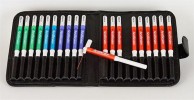Authors
B. Beyreuther, N. Callizot, T. Stöhr.
Lab
Schwarz BioSciences GmbH, Department of Pharmacology/Toxicology, Monheim, Germany
Journal
Arthritis Research & Therapy
Abstract
The etiology of osteoarthritis is multifactorial, with inflammatory, metabolic, and mechanical causes. Pain in osteoarthritis is initiated by mild intra-articular inflammation and degeneration of articular cartilage and subchondral bone. The principle of treatment with acetaminophen or non-steroidal antiinflammatory drugs is to reduce pain and improve joint function. Recently, animal models for osteoarthritic pain behavior have been established. The most frequently used rat model for analyzing properties of drugs on the pathology of osteoarthritis is the injection of the metabolic inhibitor monosodium iodoacetate into the joint, which inhibits the activity of glyceraldehyde-3-phosphate dehydrogenase in chondrocytes. Here, we characterize the effect on pain behavior of lacosamide, a member of a family of functionalized amino acids that are analogues of endogenous amino acids and D-serine, in the monosodium iodoacetate rat model for osteoarthritis in comparison to diclofenac and morphine. Lacosamide (3, 10, and 30 mg/kg) was able to reduce secondary mechanical allodynia and hyperalgesia similarly to morphine (3 mg/kg). In contrast, diclofenac (30 mg/kg) was only effective in reducing secondary mechanical hyperalgesia. During the first week, pain is induced mainly by inflammation in the iodoacetate model, but afterwards inflammation plays only a minor role in pain. Lacosamide was able to inhibit pain at days 3, 7 and 14 after induction of arthritis. This shows that lacosamide is able to reduce pain behavior induced by multiple mechanisms in animals.
BIOSEB Instruments Used:
Von Frey Filaments (Bio-VF-M)

 Pain - Thermal Allodynia / Hyperalgesia
Pain - Thermal Allodynia / Hyperalgesia Pain - Spontaneous Pain - Postural Deficit
Pain - Spontaneous Pain - Postural Deficit Pain - Mechanical Allodynia / Hyperalgesia
Pain - Mechanical Allodynia / Hyperalgesia Learning/Memory - Attention - Addiction
Learning/Memory - Attention - Addiction Physiology & Respiratory Research
Physiology & Respiratory Research
 Pain
Pain Metabolism
Metabolism Motor control
Motor control Neurodegeneration
Neurodegeneration Cross-disciplinary subjects
Cross-disciplinary subjects Muscular system
Muscular system General activity
General activity Mood Disorders
Mood Disorders Other disorders
Other disorders Joints
Joints Central Nervous System (CNS)
Central Nervous System (CNS) Sensory system
Sensory system
